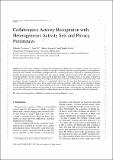Files in this item
Collaborative activity recognition with heterogeneous activity sets and privacy preferences
Item metadata
| dc.contributor.author | Civitarese, Gabriele | |
| dc.contributor.author | Ye, Juan | |
| dc.contributor.author | Zampatti, Matteo | |
| dc.contributor.author | Bettini, Claudio | |
| dc.date.accessioned | 2021-11-18T16:30:12Z | |
| dc.date.available | 2021-11-18T16:30:12Z | |
| dc.date.issued | 2021-11-23 | |
| dc.identifier | 276713389 | |
| dc.identifier | 4c17aa21-ee63-4535-8922-e097f35dc0f8 | |
| dc.identifier | 85120531110 | |
| dc.identifier | 000722636600003 | |
| dc.identifier.citation | Civitarese , G , Ye , J , Zampatti , M & Bettini , C 2021 , ' Collaborative activity recognition with heterogeneous activity sets and privacy preferences ' , Journal of Ambient Intelligence and Smart Environments , vol. 13 , no. 6 , pp. 433-452 . https://doi.org/10.3233/ais-210018 | en |
| dc.identifier.issn | 1876-1364 | |
| dc.identifier.other | Jisc: 3f33ec07101e48859f3973f05a1df5ef | |
| dc.identifier.other | ORCID: /0000-0002-2838-6836/work/103510851 | |
| dc.identifier.uri | https://hdl.handle.net/10023/24362 | |
| dc.description.abstract | One of the major challenges in Human Activity Recognition (HAR) based on machine learning is the scarcity of labeled data. Indeed, collecting a sufficient amount of training data to build a reliable recognition problem is often prohibitive. Among the many solutions in the literature to mitigate this issue, collaborative learning is emerging as a promising direction to distribute the annotation burden over multiple users that cooperate to build a shared recognition model. One of the major issues of existing methods is that they assume a static activity model with a fixed set of target activities. In this paper, we propose a novel approach that is based on Growing When Required (GWR) neural networks. A GWR network continuously adapts itself according to the input training data, and hence it is particularly suited when the users share heterogeneous sets of activities. Like in federated learning, for the sake of privacy preservation, each user contributes to the global activity classifier by sharing personal model parameters, and not by directly sharing data. In order to further mitigate privacy threats, we implement a strategy to avoid releasing model parameters that may indirectly reveal information about activities that the user specifically marked as private. Our results on two well-known publicly available datasets show the effectiveness and the flexibility of our approach. | |
| dc.format.extent | 20 | |
| dc.format.extent | 1606399 | |
| dc.language.iso | eng | |
| dc.relation.ispartof | Journal of Ambient Intelligence and Smart Environments | en |
| dc.subject | Activity recognition | en |
| dc.subject | Collaborative learning | en |
| dc.subject | Semi-supervised learning, | en |
| dc.subject | Privacy | en |
| dc.subject | QA75 Electronic computers. Computer science | en |
| dc.subject | 3rd-DAS | en |
| dc.subject | AC | en |
| dc.subject | MCC | en |
| dc.subject.lcc | QA75 | en |
| dc.title | Collaborative activity recognition with heterogeneous activity sets and privacy preferences | en |
| dc.type | Journal article | en |
| dc.contributor.institution | University of St Andrews. School of Computer Science | en |
| dc.identifier.doi | https://doi.org/10.3233/ais-210018 | |
| dc.description.status | Peer reviewed | en |
This item appears in the following Collection(s)
Items in the St Andrews Research Repository are protected by copyright, with all rights reserved, unless otherwise indicated.

